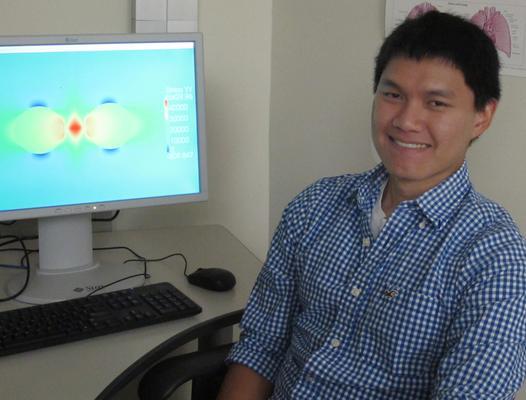Feature
Published Aug. 25, 2015

Maytee Chantharayukhonthorn, a senior in aerospace engineering honors, and biochemistry, received the 2015 Graham F. Carey Computational Science Scholarship.
Nominated by ICES Professor Thomas J.R. Hughes who employed him in his research group this past year, Hughes characterized Chantharayukhonthorn as “demonstrating great potential for advanced research.”
“Maytee is eager and enthusiastic, and despite not yet having the benefit of a comprehensive graduate program of study, he has shown considerable aptitude and ability in the projects he has participated in,” Hughes said.
"This award means many things to me," Chantharayukhonthorn said. "As an aerospace engineering freshman I came to school here expecting to build rockets and airplanes. The opportunities with Dr. Hughes showed me a new direction to take my computational skills that can benefit society in ways I hadn't considered."
Chantharayukhonthorn said the scholarship will support the addition of a biochemistry degree to the aerospace engineering bachelor's degree requirements he has already completed.
"The award provided more encouragement to pursue this new direction," Chantharayukhonthorn said.
Chantharayukhonthorn was mentored in several areas throughout the year--by Dr. Ming-Chen Hsu in computational fluid dynamics and fluid-structure interaction, by Dr. Michael Borden in computational fracture mechanics, and most recently by Dr. Shaolie Hossain in cardiovascular medicine.
In Fall 2013, Chantharayukhonthorn began work on a phase-field description of dynamic fracture. He studied problems of classical fracture mechanics and performed computer simulations of fracture of engineering materials. He is continuing this work presently with a goal of investigating the rupture of so-called “vulnerable plaques”--lipid pools that form in artery walls and are separated from the blood stream by a thin fibrous cap. If the cap ruptures, the emboli are released into the bloodstream and clot within a second, blocking flow. If this occurs in a coronary artery, the result is a heart attack. It is estimated about 70 percent of heart attacks are caused by vulnerable plaques.
Standard angiography is not capable of detecting vulnerable plaques since, prior to rupture, they do not block flow to a significant degree. Presently, there is no means of treatment, although systemic administration of statins is partially effective. The problem of vulnerable plaques represents a huge unmet clinical problem, Hughes said. Chantharayukhonthorn pursued this topic by developing computer models and studying the propensity of vulnerable plaques to rupture under various scenarios. This could provide a test bed to examine the efficacy of various treatment procedures that would possibly stabilize vulnerable plaques.
Chantharayukhonthorn also proved to be an independent thinker and active learner, said Hughes.
In Spring 2013 he was assigned a project using isogeometric analysis to study the effect of computational domain size on flow quantities of interest. With a very brief introduction to the idea and to an in-house research code, he was able to quickly build NURBS (Non-Uniform Rational B-Spline) geometries and perform parallel computational fluid dynamics analysis on the Texas Advanced Computing Center (TACC) high-performance computers. He also developed his own Python (a high-level computing language) scripts to accelerate and automate the process.
“When Maytee experienced difficulties, he was able to systematically identify and isolate them, and quickly came up with solutions,” said Hughes. “At the project completion, he generated a professional-quality report documenting findings and contributions.”
“Maytee has great potential and a brilliant future. He has the capacity to learn new things and become productive very quickly. He has a tremendous appetite for scholarly research and will make a brilliant graduate student,” said Hughes.
In order to develop the skill set necessary to pursue future work in Computational Medicine, Chantharayukhonthorn is now pursuing a second major in Biochemistry.
“This confluence of biological, medical, and engineering technologies will provide him with a unique background to pursue research,” said Hughes.
“On a personal level, Maytee is mature, friendly, has a very good sense of humor, and a congenial personality. He is a pleasure to interact with.”